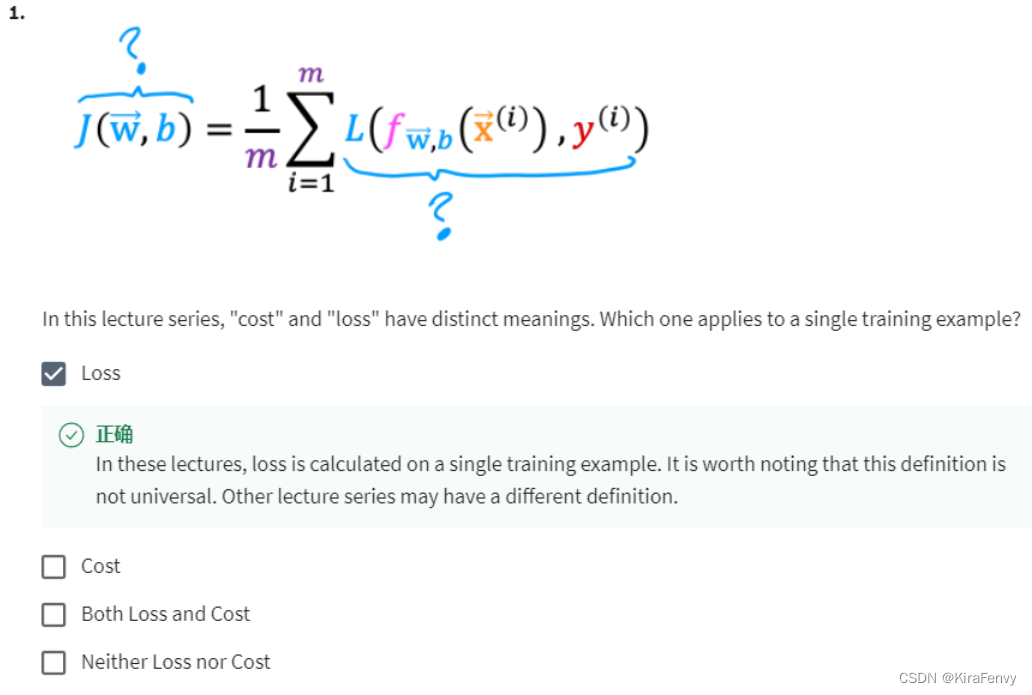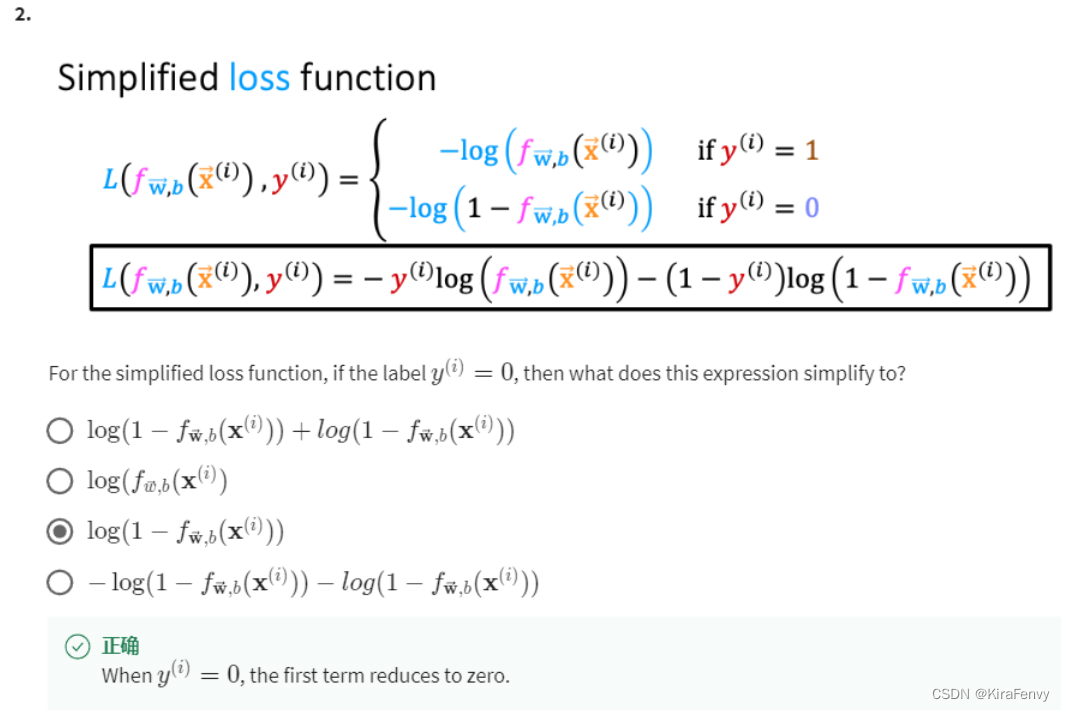主要研究逻辑回归的损失和代价问题,理论与实践结合
1.导入
import numpy as np
%matplotlib widget
import matplotlib.pyplot as plt
from plt_logistic_loss import plt_logistic_cost, plt_two_logistic_loss_curves, plt_simple_example
from plt_logistic_loss import soup_bowl, plt_logistic_squared_error
plt.style.use('./deeplearning.mplstyle')
2.逻辑回归的代价
squared error cost function 平方误差成本函数:
The equation for the squared error cost with one variable is 含一个变量的平方误差代价函数:
J
(
w
,
b
)
=
1
2
m
∑
i
=
0
m
?
1
(
f
w
,
b
(
x
(
i
)
)
?
y
(
i
)
)
2
(1)
J(w,b) = \frac{1}{2m} \sum\limits_{i = 0}^{m-1} (f_{w,b}(x^{(i)}) - y^{(i)})^2 \tag{1}
J(w,b)=2m1?i=0∑m?1?(fw,b?(x(i))?y(i))2(1)
where
f
w
,
b
(
x
(
i
)
)
=
w
x
(
i
)
+
b
(2)
f_{w,b}(x^{(i)}) = wx^{(i)} + b \tag{2}
fw,b?(x(i))=wx(i)+b(2)
x_train = np.array([0., 1, 2, 3, 4, 5],dtype=np.longdouble)
y_train = np.array([0, 0, 0, 1, 1, 1],dtype=np.longdouble)
plt_simple_example(x_train, y_train)
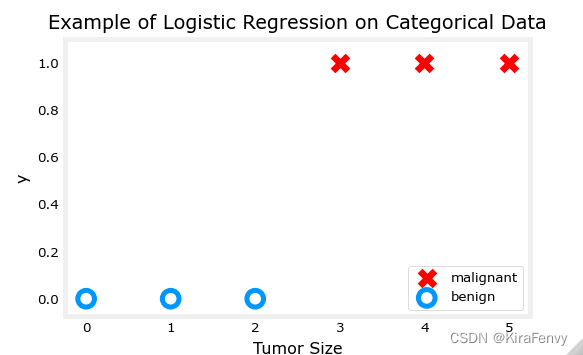
Now, let’s get a surface plot of the cost using a squared error cost:
J
(
w
,
b
)
=
1
2
m
∑
i
=
0
m
?
1
(
f
w
,
b
(
x
(
i
)
)
?
y
(
i
)
)
2
J(w,b) = \frac{1}{2m} \sum\limits_{i = 0}^{m-1} (f_{w,b}(x^{(i)}) - y^{(i)})^2
J(w,b)=2m1?i=0∑m?1?(fw,b?(x(i))?y(i))2
where
f
w
,
b
(
x
(
i
)
)
=
s
i
g
m
o
i
d
(
w
x
(
i
)
+
b
)
f_{w,b}(x^{(i)}) = sigmoid(wx^{(i)} + b )
fw,b?(x(i))=sigmoid(wx(i)+b)
plt.close('all')
plt_logistic_squared_error(x_train,y_train)
plt.show()
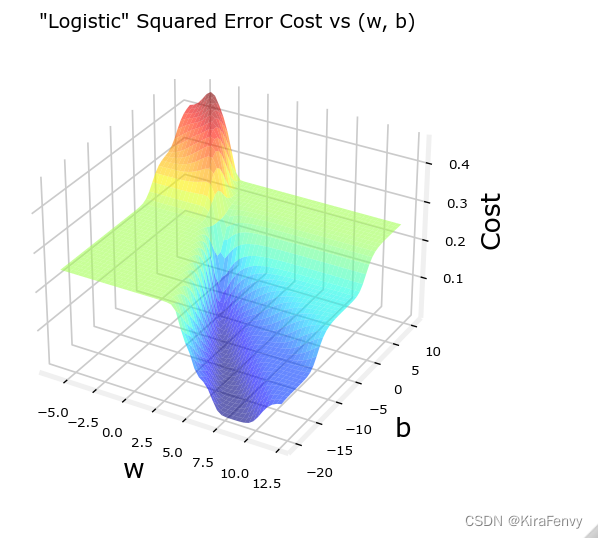
下面这是线性回归的
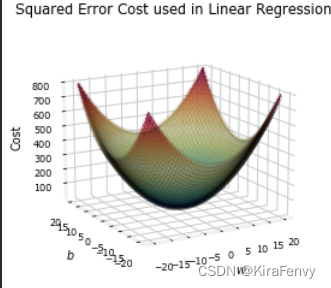
Logistic Regression使用的损失函数更适合目标为0或1而不是任何数字的分类任务。
Definition Note: In this course, these definitions are used:
Loss is a measure of the difference of a single example to its target value while the 损失是用来衡量单个数据与目标的差值
Cost is a measure of the losses over the training set 代价是用来衡量整个训练集上的损失
3.损失函数
损失是用来衡量单个数据与目标的差值,而代价是用来衡量整个训练集上的损失
This is defined:
- l o s s ( f w , b ( x ( i ) ) , y ( i ) ) loss(f_{\mathbf{w},b}(\mathbf{x}^{(i)}), y^{(i)}) loss(fw,b?(x(i)),y(i)) is the cost for a single data point, which is:

-
f w , b ( x ( i ) ) f_{\mathbf{w},b}(\mathbf{x}^{(i)}) fw,b?(x(i)) is the model’s prediction, while y ( i ) y^{(i)} y(i) is the target value.
-
f w , b ( x ( i ) ) = g ( w ? x ( i ) + b ) f_{\mathbf{w},b}(\mathbf{x}^{(i)}) = g(\mathbf{w} \cdot\mathbf{x}^{(i)}+b) fw,b?(x(i))=g(w?x(i)+b) where function g g g is the sigmoid function.
此损失函数的定义特征是它使用两条单独的曲线。一个用于目标为零(
y
=
0
y=0
y=0)的情况,另一个用于当目标为一(
y
=
1
y=1
y=1)时的情况。结合起来,这些曲线提供了对损失函数有用的表示,即,当预测与目标匹配时为零,当预测不同于目标时,值迅速增加。考虑以下曲线
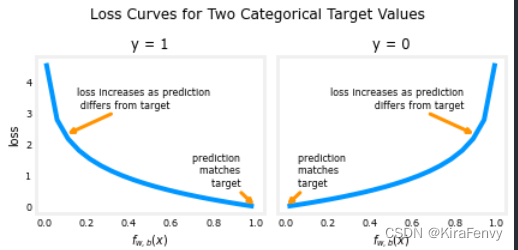
上面的损失函数可以写成更简单的形式
l
o
s
s
(
f
w
,
b
(
x
(
i
)
)
,
y
(
i
)
)
=
(
?
y
(
i
)
log
?
(
f
w
,
b
(
x
(
i
)
)
)
?
(
1
?
y
(
i
)
)
log
?
(
1
?
f
w
,
b
(
x
(
i
)
)
)
loss(f_{\mathbf{w},b}(\mathbf{x}^{(i)}), y^{(i)}) = (-y^{(i)} \log\left(f_{\mathbf{w},b}\left( \mathbf{x}^{(i)} \right) \right) - \left( 1 - y^{(i)}\right) \log \left( 1 - f_{\mathbf{w},b}\left( \mathbf{x}^{(i)} \right) \right)
loss(fw,b?(x(i)),y(i))=(?y(i)log(fw,b?(x(i)))?(1?y(i))log(1?fw,b?(x(i)))
上面那个式子看起来有点吓人,其实
y
(
i
)
y^{(i)}
y(i) 只有两个值 0 and 1.
当
y
(
i
)
=
0
y^{(i)} = 0
y(i)=0 式子变成
l
o
s
s
(
f
w
,
b
(
x
(
i
)
)
,
0
)
=
(
?
(
0
)
log
?
(
f
w
,
b
(
x
(
i
)
)
)
?
(
1
?
0
)
log
?
(
1
?
f
w
,
b
(
x
(
i
)
)
)
=
?
log
?
(
1
?
f
w
,
b
(
x
(
i
)
)
)
\begin{align} loss(f_{\mathbf{w},b}(\mathbf{x}^{(i)}), 0) &= (-(0) \log\left(f_{\mathbf{w},b}\left( \mathbf{x}^{(i)} \right) \right) - \left( 1 - 0\right) \log \left( 1 - f_{\mathbf{w},b}\left( \mathbf{x}^{(i)} \right) \right) \\ &= -\log \left( 1 - f_{\mathbf{w},b}\left( \mathbf{x}^{(i)} \right) \right) \end{align}
loss(fw,b?(x(i)),0)?=(?(0)log(fw,b?(x(i)))?(1?0)log(1?fw,b?(x(i)))=?log(1?fw,b?(x(i)))??
当
y
(
i
)
=
1
y^{(i)} = 1
y(i)=1 式子变成
l
o
s
s
(
f
w
,
b
(
x
(
i
)
)
,
1
)
=
(
?
(
1
)
log
?
(
f
w
,
b
(
x
(
i
)
)
)
?
(
1
?
1
)
log
?
(
1
?
f
w
,
b
(
x
(
i
)
)
)
=
?
log
?
(
f
w
,
b
(
x
(
i
)
)
)
\begin{align} loss(f_{\mathbf{w},b}(\mathbf{x}^{(i)}), 1) &= (-(1) \log\left(f_{\mathbf{w},b}\left( \mathbf{x}^{(i)} \right) \right) - \left( 1 - 1\right) \log \left( 1 - f_{\mathbf{w},b}\left( \mathbf{x}^{(i)} \right) \right)\\ &= -\log\left(f_{\mathbf{w},b}\left( \mathbf{x}^{(i)} \right) \right) \end{align}
loss(fw,b?(x(i)),1)?=(?(1)log(fw,b?(x(i)))?(1?1)log(1?fw,b?(x(i)))=?log(fw,b?(x(i)))??
这个损失函数,可以生成一个成本函数,它包含了所有示例中的损失,下面会讨论
plt.close('all')
cst = plt_logistic_cost(x_train,y_train)
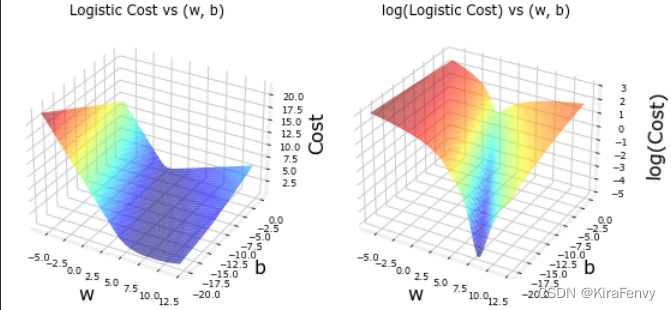
这条曲线非常适合梯度下降!它没有高原、局部极小值或间断(plateaus, local minima, or discontinuities)。注意,在平方误差的情况下,它不是一个碗。绘制成本和成本对数以说明这样一个事实,即当成本较小时,曲线有一个斜率,并继续下降。
4.从损失函数得出代价函数
4.1 导入
import numpy as np
%matplotlib widget
import matplotlib.pyplot as plt
from lab_utils_common import plot_data, sigmoid, dlc
plt.style.use('./deeplearning.mplstyle')
4.2 数据载入与分析
X_train = np.array([[0.5, 1.5], [1,1], [1.5, 0.5], [3, 0.5], [2, 2], [1, 2.5]]) #(m,n)
y_train = np.array([0, 0, 0, 1, 1, 1])
绘图
fig,ax = plt.subplots(1,1,figsize=(4,4))
plot_data(X_train, y_train, ax)
# Set both axes to be from 0-4
ax.axis([0, 4, 0, 3.5])
ax.set_ylabel('$x_1$', fontsize=12)
ax.set_xlabel('$x_0$', fontsize=12)
plt.show()
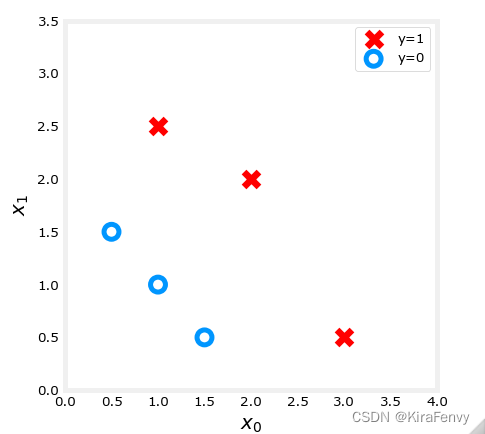
4.3 逻辑回归的代价计算
这里是把所有数据的loss合并为整个函数的cost
J ( w , b ) = 1 m ∑ i = 0 m ? 1 [ l o s s ( f w , b ( x ( i ) ) , y ( i ) ) ] (1) J(\mathbf{w},b) = \frac{1}{m} \sum_{i=0}^{m-1} \left[ loss(f_{\mathbf{w},b}(\mathbf{x}^{(i)}), y^{(i)}) \right] \tag{1} J(w,b)=m1?i=0∑m?1?[loss(fw,b?(x(i)),y(i))](1)
where
-
l o s s ( f w , b ( x ( i ) ) , y ( i ) ) loss(f_{\mathbf{w},b}(\mathbf{x}^{(i)}), y^{(i)}) loss(fw,b?(x(i)),y(i)) is the cost for a single data point, which is:
l o s s ( f w , b ( x ( i ) ) , y ( i ) ) = ? y ( i ) log ? ( f w , b ( x ( i ) ) ) ? ( 1 ? y ( i ) ) log ? ( 1 ? f w , b ( x ( i ) ) ) (2) loss(f_{\mathbf{w},b}(\mathbf{x}^{(i)}), y^{(i)}) = -y^{(i)} \log\left(f_{\mathbf{w},b}\left( \mathbf{x}^{(i)} \right) \right) - \left( 1 - y^{(i)}\right) \log \left( 1 - f_{\mathbf{w},b}\left( \mathbf{x}^{(i)} \right) \right) \tag{2} loss(fw,b?(x(i)),y(i))=?y(i)log(fw,b?(x(i)))?(1?y(i))log(1?fw,b?(x(i)))(2)
-
where m is the number of training examples in the data set and:
f w , b ( x ( i ) ) = g ( z ( i ) ) z ( i ) = w ? x ( i ) + b g ( z ( i ) ) = 1 1 + e ? z ( i ) \begin{align} f_{\mathbf{w},b}(\mathbf{x^{(i)}}) &= g(z^{(i)})\\ z^{(i)} &= \mathbf{w} \cdot \mathbf{x}^{(i)}+ b \\ g(z^{(i)}) &= \frac{1}{1+e^{-z^{(i)}}} \end{align} fw,b?(x(i))z(i)g(z(i))?=g(z(i))=w?x(i)+b=1+e?z(i)1???
计算代码:
def compute_cost_logistic(X, y, w, b):
"""
Computes cost
Args:
X (ndarray (m,n)): Data, m examples with n features
y (ndarray (m,)) : target values
w (ndarray (n,)) : model parameters
b (scalar) : model parameter
Returns:
cost (scalar): cost
"""
m = X.shape[0]
cost = 0.0
for i in range(m):
z_i = np.dot(X[i],w) + b
f_wb_i = sigmoid(z_i)
cost += -y[i]*np.log(f_wb_i) - (1-y[i])*np.log(1-f_wb_i)
cost = cost / m
return cost
调用上述代码
w_tmp = np.array([1,1])
b_tmp = -3
print(compute_cost_logistic(X_train, y_train, w_tmp, b_tmp))
4.4 举例计算
把上述代码应用在具体例子中
看看 w w w的不同值输出的cost函数.
-
In a previous lab, you plotted the decision boundary for b = ? 3 , w 0 = 1 , w 1 = 1 b = -3, w_0 = 1, w_1 = 1 b=?3,w0?=1,w1?=1. That is, you had
w = np.array([-3,1,1]). -
Let’s say(假设) you want to see if b = ? 4 , w 0 = 1 , w 1 = 1 b = -4, w_0 = 1, w_1 = 1 b=?4,w0?=1,w1?=1, or
w = np.array([-4,1,1])provides a better model.
Let’s first plot the decision boundary for these two different b b b values to see which one fits the data better.
- For b = ? 3 , w 0 = 1 , w 1 = 1 b = -3, w_0 = 1, w_1 = 1 b=?3,w0?=1,w1?=1, we’ll plot ? 3 + x 0 + x 1 = 0 -3 + x_0+x_1 = 0 ?3+x0?+x1?=0 (shown in blue)
- For b = ? 4 , w 0 = 1 , w 1 = 1 b = -4, w_0 = 1, w_1 = 1 b=?4,w0?=1,w1?=1, we’ll plot ? 4 + x 0 + x 1 = 0 -4 + x_0+x_1 = 0 ?4+x0?+x1?=0 (shown in magenta)
import matplotlib.pyplot as plt
# Choose values between 0 and 6
x0 = np.arange(0,6)
# Plot the two decision boundaries
x1 = 3 - x0
x1_other = 4 - x0
fig,ax = plt.subplots(1, 1, figsize=(4,4))
# Plot the decision boundary
ax.plot(x0,x1, c=dlc["dlblue"], label="$b$=-3")
ax.plot(x0,x1_other, c=dlc["dlmagenta"], label="$b$=-4")
ax.axis([0, 4, 0, 4])
# Plot the original data
plot_data(X_train,y_train,ax)
ax.axis([0, 4, 0, 4])
ax.set_ylabel('$x_1$', fontsize=12)
ax.set_xlabel('$x_0$', fontsize=12)
plt.legend(loc="upper right")
plt.title("Decision Boundary")
plt.show()
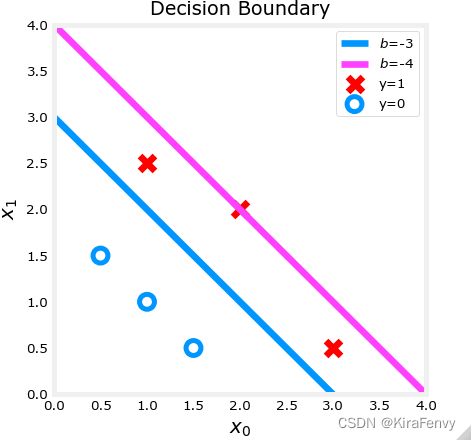
w_array1 = np.array([1,1])
b_1 = -3
w_array2 = np.array([1,1])
b_2 = -4
print("Cost for b = -3 : ", compute_cost_logistic(X_train, y_train, w_array1, b_1))
print("Cost for b = -4 : ", compute_cost_logistic(X_train, y_train, w_array2, b_2))
Cost for b = -3 : 0.36686678640551745
Cost for b = -4 : 0.5036808636748461
5.课后题
